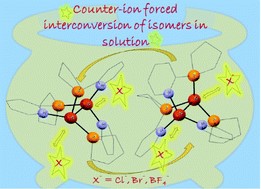by A. Shamsieva, E. Musina, T. Gerasimova, I. Strelnik, A. Strelnik, I. Kolesnikov, A. Kalinichev, D. Islamov, A. Samigullina, P. Lӧnnecke, S. Katsyubaa, E. Hey-Hawkins, A. Karasik, O. Sinyashin
Dalton Trans., 2020,49, 11997-12008
https://doi.org/10.1039/D0DT01843K

A family of helical dinuclear copper(I) pyridylphospholane complexes [Cu2L3X]X (X = BF4−, Cl− and Br−) was prepared. The family includes the first examples of this type of complex based on copper(I) chloride and copper(I) bromide. The two isomers typical of this class of compounds, namely head-to-head and head-to-tail complexes, were studied in solution by spectroscopic and optical methods, and in the solid state by X-ray diffraction. Furthermore, the solid-state luminescence of the complexes at different temperatures was studied, and the results were interpreted using quantum-chemical calculations. It was shown that the luminescence of the complexes is attributed to the 3(M + X)LCT transitions.




